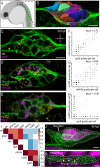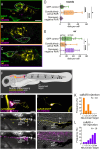Axon targeting of transcriptionally distinct pioneer neurons is regulated by retinoic acid signaling
- PMID: 40593691
- PMCID: PMC12215742
- DOI: 10.1038/s41467-025-61044-1
Axon targeting of transcriptionally distinct pioneer neurons is regulated by retinoic acid signaling
Abstract
During nervous system development, pioneer neurons (pioneers) extend their axons toward distant targets, creating a scaffold for follower neurons and defining the initial structure of the nervous system. Despite years of study, whether pioneer neurons are transcriptionally distinct from followers is unknown. To address this question, we performed single-cell RNA sequencing (scRNA-seq) of zebrafish posterior lateral line (pLL) sensory neurons and found that pioneers and followers are transcriptionally distinct populations. Interestingly, expression profiling of differentiating pLL progenitors defines "follower" as the ground state and "pioneer" as a later developmental state, with retinoic acid (RA) signaling active in all pLL progenitors. Modulation of RA signaling within single pLL neurons demonstrated that its downregulation is necessary for expression of a neurotrophic factor receptor ret, which is required for correct targeting of pioneer axons. Our study reveals molecular heterogeneity between pioneers and followers and implicates RA signaling in fidelity of pioneer axonal targeting.
© 2025. The Author(s).
Conflict of interest statement
Competing interests: The authors declare no competing interests. Inclusion & ethics statement: This research aligns with the Inclusion & ethical guidelines embraced by Nature Communications.
Figures








References
-
- Bate, C. M. Pioneer neurones in an insect embryo. Nature260, 54–56 (1976). - PubMed
-
- Ho, R. K. & Goodman, C. S. Peripheral pathways are pioneered by an array of central and peripheral neurones in grasshopper embryos. Nature297, 404–406 (1982). - PubMed
-
- Lin, D. M., Auld, V. J. & Goodman, C. S. Targeted neuronal cell ablation in the Drosophila embryo: pathfinding by follower growth cones in the absence of pioneers. Neuron14, 707–715 (1995). - PubMed
MeSH terms
Substances
Grants and funding
- R01 NS111419/NS/NINDS NIH HHS/United States
- NS111419/U.S. Department of Health & Human Services | NIH | National Institute of Neurological Disorders and Stroke (NINDS)
- R21 NS112795/NS/NINDS NIH HHS/United States
- T32 CA254888/CA/NCI NIH HHS/United States
- T32CA254888/U.S. Department of Health & Human Services | NIH | National Cancer Institute (NCI)
LinkOut - more resources
Full Text Sources

